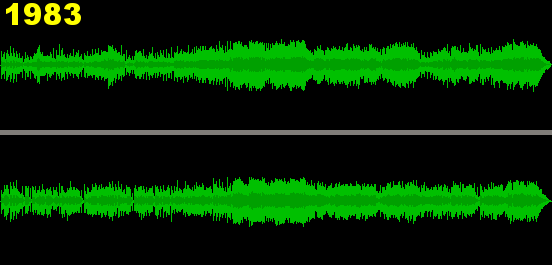The Loudness War: Does it still matter for DJs?

Why Our Brains Think Louder is Better
In the audio industry, "louder" has long been perceived as "better". This simple, almost primal, perception of sound sparked a decades-long trend in the music industry. Basically a technological race to produce the most impactful and attention-grabbing tracks. This arms-race is also known as the Loudness War. What began as a quest for musical impact has left behind a complex legacy, that DJs still navigate every time they perform.
But let's take one step back and look at the reason for this primal perception. It's crucial to distinguish between physical sound pressure, measured in decibels (dB SPL), and loudness, which is a subjective, perceptual experience. The reason for this distinction is that our hearing is not linear. Our perception of how loud a sound is changes drastically with its frequency, a principle famously illustrated by the equal-loudness contours (or Fletcher-Munson curves).

Fletcher-Munson and Equal-Loudness Curves
These curves show that at lower levels, our hearing is most sensitive to midrange frequencies, while bass and treble seem to fall into the background. As the volume increases, the low and high frequencies become far more prominent, creating a sound that feels fuller and more powerful. This quirk of human hearing means that in a direct A/B comparison, a louder track will often feel more impressive, tricking our brain into perceiving it as having higher quality. To create a modern standard that reliably measures this complex perception, the LUFS (Loudness Units Full Scale) metric was developed, which is now used by streaming platforms to normalize audio.
The immediate impact of a louder track, however, often comes at the cost of musical dynamics, depth, and the introduction of distortion. To achieve these higher average levels, audio engineers must use heavy dynamic range compression. This process squashes the difference between the loudest and quietest parts of a song. While it makes the overall track louder, it can erase the subtle variations: For example the initial attack or punch of a kick drum. Furthermore, by forcing every element in the mix to a similar level of intensity, heavy compression flattens the perceived three-dimensional space of a recording, collapsing the natural depth between instruments. Pushed to its limits, this process can also introduce unpleasant digital distortion, making the audio sound harsh and fatiguing.

Compression of music has increased over the years
From Radio Wars to Streaming Peace
Looking back at the actual Loudness War, the pursuit of loudness wasn't a sudden event but a gradual escalation over decades. The first seeds were sown in the 1950s, as early radio stations competed to sound more prominent on the dial than their competitors. The race intensified in the 1980s when the introduction of digital technology made achieving extreme loudness technically feasible. By the early to mid-2000s, the "loudness war" had reached its peak, and highly compressed recordings became the industry standard.
For the average music consumer, the loudness war is largely a thing of the past. Since the 2010s, major streaming services such as Spotify and YouTube have implemented so-called loudness normalization standards. These standards ensure a consistent listening experience by automatically analyzing and adjusting the playback volume of all tracks, thereby leveling the playing field. This normalization highlighted the degraded sound quality of overcompressed songs compared to those mastered at reasonable levels, removing the incentive for artists to prioritize loudness above all else.
The DJ's Ongoing Battle
However, the story is very different in the DJ booth. The war may be over for the consumer, but for DJs, the battlefield has simply shifted to the club or platforms like SoundCloud.
A DJ's music library is a living history of this audio evolution, containing tracks from every era, each with its own loudness characteristics. When mixing, the DJ is navigating the fallout in real-time. Unlike streaming platforms, DJ mixers do not have built-in loudness normalization, and neither do many platforms like SoundCloud that are popular for sharing music. This is often compounded by challenging monitoring situations in live venues.

Loudness of modern tracks is significantly different
As a result, that moment when a quiet, dynamic vinyl rip from the 90s sounds weak next to the hyper-compressed banger from last week isn't a failure of the music; it's a direct consequence of this history. The frantic scramble to ride the gain knob is the modern DJ's inheritance of this loudness race. The solution isn't to get better at fighting the levels live, but to prepare your music beforehand, bringing a modern standard of consistency to your entire collection before you ever press play.
References
- Equal Loudness Contours (University of Salford)
- The Loudness Wars Why Music Has Gotten Louder (NPR)
- YouTube, Spotify, Apple Music - Which Loudness Do I Need? (Production Advice)
- Waveform image of "Something" by The Beatles, from the CD albums Abbey Road (Toshiba), Abbey Road (EMI), 1967-1970, 1
- Fletcher-Munson Curves
Like what you see? Share with a friend.
Yannik Brehm
Yannik is a multifaceted professional whose career merges audio-engineering, software-development and music production. Currently working as a Senior Audio System Engineer specializing in automotive audio solutions and embedded development, he leverages a Master's degree in Media Informatics and experience in professional real-time audio software development for companies like Sennheiser. His technical expertise is complemented by practical knowledge and critical listening skills gained through years of producing, mixing and mastering electronic music.
Ready for perfectly balanced audio?
Join the WaveAlign beta today and take control of your sound.